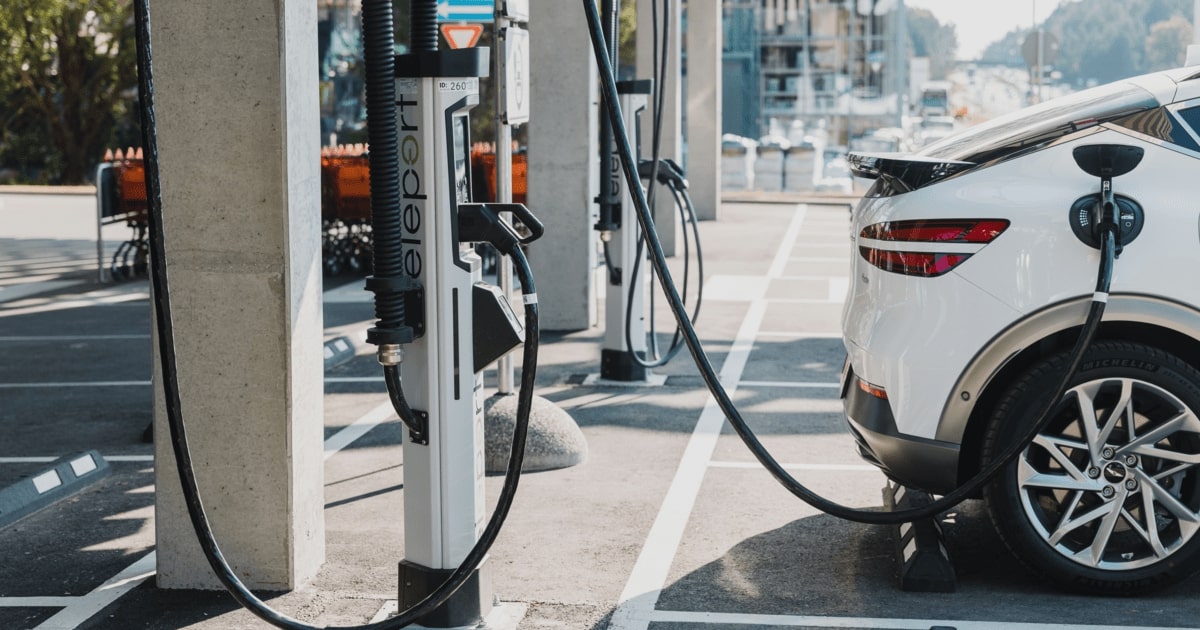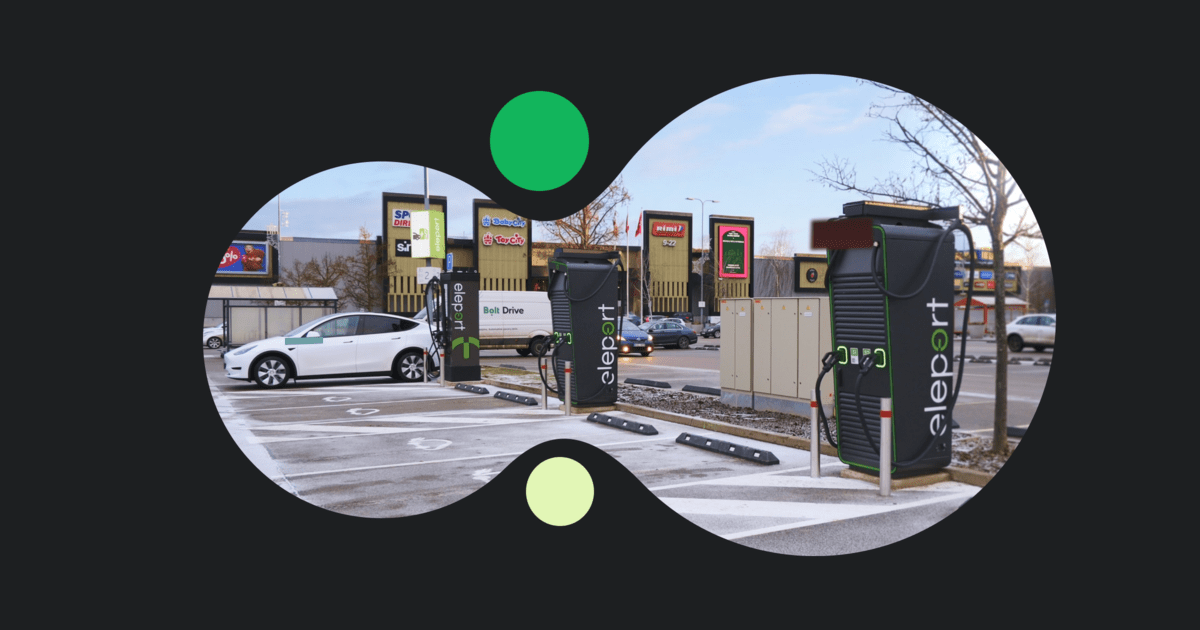If you’ve noticed another EV charging point outside your local supermarket, you’ve probably asked: Should my next car be electric?
Across Europe and beyond, more drivers are making that choice. In fact, in 2024, every 7th car sold worldwide was already fully electric. And while our European countries vary in adoption, the average for the whole of Europe landed on every 7th being EV too. Some seek lower costs. Others want cleaner air. Many people feel curious when a sleek electric vehicle glides silently in traffic. With EV chargers from Eleport now available in cities, towns, and on highways, the electric future feels more real than ever. But switching vehicles is about more than plugging in; it’s about your lifestyle, budget, and driving habits.
This guide breaks down the real pros and cons of EV vs ICE — from cost and efficiency to carbon footprint and performance.
Key Differences Between EV and ICE Vehicles
Put simply, EVs power a motor from stored electricity. ICE cars burn fuel to move.
Electric cars are pretty simple when you think about it. You plug in an electric car, and it charges up a battery. That battery powers electric motors that get the car moving. It’s a simple setup — fewer moving parts, no exhaust pipe, no loud noise. And because it’s less complicated, there are fewer parts that can break or need fixing. Plus, no emissions coming out the back, which is a win for the environment.
Combustion cars are a bit more old-school. They burn gasoline or diesel to move pistons inside the engine. It’s powerful, no doubt, but not very efficient — a lot of the energy turns into heat instead of motion. Plus, they’re noisier, pollute more, and cost more to maintain over time, with things like oil changes, spark plug swaps, and exhaust repairs.
At the end of the day, the big difference is how much of the energy actually goes into moving you forward. Electric cars are way more efficient — they use most of the energy they’ve got from refueling to drive you. Gas cars lose a lot of it before you even leave the driveway.
What is an ICE Vehicle?
An Internal Combustion Engine (ICE) vehicle burns fossil fuels to drive pistons and move the car. This system, which has been around since the late 1800s, remains reliable and powerful but feels outdated in light of today’s environmental goals.
Where ICE Vehicles Shine:
- Quick refuelling almost anywhere
- Reliable for long-distance or rural driving
- Easy access to repairs and mechanics
- Cheaper upfront price when purchasing the car
- Wide selection of already established models and brands
Where ICE Vehicles Struggle:
- Frequent maintenance: oil changes, exhaust fixes, transmission repairs
- High emissions: CO₂, nitrogen oxides, particulates
- Depending on the fossil fuel prices, it uses fuel that a person can’t generate themselves
- Increasing restrictions in urban areas
- Inability to consistently and easily refuel at home, needs gas station trips
- Noisy: although technology is advancing, it can’t be fully eliminated
In any EV vs ICE carbon footprint analysis, ICE vehicles consistently fall behind.
What is an EV (Electric Vehicle)?
An Electric Vehicle (EV) skips the gas station. It stores energy in a large battery and powers electric motors for smooth, instant acceleration. Learn more about what is EV.
Why EVs Stand Out:
- Efficiency: EVs convert 85% or more of energy into motion, compared to 20–30% for ICEs.
- Performance: Electric motors deliver instant torque with no gear shifts.
- Maintenance: No oil changes, mufflers, or transmission repairs.
- Energy to power an EV can be produced at home and integrates well with smart energy systems.
- Home charging: EVs can easily be refueled right at home.
- Quiet: the cities with high EV adoption are remarkably quieter.
- Better over time: already often offer a highly digital experience, and are upgraded constantly over the air.
A Word of Caution:
EVs are not perfect. Battery degradation is real, especially if you live in a very hot or cold climate. According to large sets of existing EV fleets, most modern EVs only lose 1.8% of their battery health per year on average (per Geotab). That means after 8 years, most batteries still retain over 85% of their capacity.”
EV vs ICE Efficiency
When you stack up the numbers, it’s not even close: EVs crush ICE vehicles on efficiency. Electric cars convert more than 85% of the energy from their batteries directly into motion.
ICE vehicles? They barely hit 20–30%, with the rest wasted as heat, noise, and friction under the hood. That’s a staggering gap — and it’s one of the biggest reasons why EVs are pulling ahead.
But there’s another hidden bonus:
Using less energy means putting less strain on the power grid, especially now that some EVs can even push electricity back into the system when needed. In other words, going electric doesn’t just help your wallet — it also quietly strengthens the entire energy network.
EV vs ICE Carbon Footprint
Let’s look at some real numbers when it comes to the carbon footprint of EVS vs ICE.
- An average ICE vehicle puts out about 4.6 metric tons of CO₂ every year.
- An average EV, even factoring in today’s electricity grid, comes in closer to 2 metric tons a year.

That is already a huge difference. And the gap is only going to get bigger. As more renewable energy sources, such as solar and wind power, are added to the grid, the EV carbon footprint will continue to decrease.
Another added EV benefit is the location where the unavoidable emissions are released. In the case of a combustion car, emissions come out of the tailpipe when the car is used for driving, thus polluting the air right where we live and work. With EVs, the unavoidable emissions – the ones that come from either dirtier energy generation sources or from producing the components such as batteries – are released in the air near people’s everyday lives.
The International Energy Agency says that EVs sold today already have about half the lifetime emissions of gas cars on average. And by 2035, electric cars could end up producing less than a third of the emissions of combustion ones, mainly because the power grid is getting cleaner.
EV vs ICE Cost of Ownership
Let’s be honest — cost matters to everyone. And when you compare the cost of ownership in the EV vs ICE debate, EVs make a lot more sense.
Upfront price: EVs still cost more initially; there’s no way around it, yet. Until we reach price parity with combustion vehicles over time, depending on where you live in Europe, you may qualify for incentives of €4,500 to €9,000 for purchasing an EV. In some countries, incentives are even offered to cover the cost of installing a home charger.
Fuel cost: EVs typically cost about 2.5 to 3 euro cents per kilometre to run, even less with overnight home charging. Petrol and diesel cars cost closer to 7 to 9 euro cents per kilometre at today’s prices – that’s up to more than 3 times more expensive per every kilometre!
Maintenance: EV owners share that their only service costs are mainly brakes and tires, and even the brakes tend to wear out less, thanks to the regenerative braking. ICE cars require much more care by default: oil changes, spark plugs, fuel pumps, — as we all know, the list goes on.
Tolls and emission zones: In many countries, EVs are exempt from some or all toll booth fees, and can access the low-emission zones of the cities with no extra cost compared to ICE.
Over five years, most EV owners save between €5,500 and €9,500 compared to owning a similar ICE vehicle, or more, not counting additional tax benefits.
Pro tip: Use a trusted network like the Eleport EV charging stations map to find chargers easily. It makes electric driving just as convenient as owning a petrol car, only much cheaper.
| Factor | EV | ICE |
| Fuel Source | Electricity (increasingly from renewables) | Petrol/Diesel |
| CO₂ Emissions | Zero tailpipe; lower lifetime emissions | High emissions, especially diesel |
| Urban Mobility | Favoured by clean air zones (LEZs, ULEZs) | Increasingly restricted in cities |
| Fuel Cost | Lower, especially with home/workplace charging | Volatile; affected by global oil prices |
| Maintenance | Lower: fewer moving parts, no oil changes | Higher: regular oil changes, more wear & tear due to a higher number of parts |
What are the Benefits of Electric Cars?

Thinking about getting an electric car? You’re not alone — and it’s not just about saving the planet (though that’s a pretty big bonus). Here are the benefits of electric cars and why so many people are making the switch:
Lower total cost of ownership
Even if an EV costs a little more upfront, the lifetime savings on fuel, maintenance, and repairs often make it cheaper overall.
Better performance
EVs aren’t just about saving money — many are fast, too. Instant torque means they can accelerate quicker than nearly any comparable gas car, and their sports trim. And the fact that the torque is instantly available also at higher speeds makes passing any cars on highways that much easier.
Less maintenance stress
Say goodbye to oil changes, transmission repairs, and muffler replacements. EVs skip a lot of the usual car headaches.
Energy flexibility
Charge at home, at work, or on the go. With public charging networks growing fast, you’ll have more options than ever to power up wherever life takes you.
Cleaner future fuels
As the electric grid becomes greener (with more wind, solar, and other renewable energies), EVs automatically become cleaner over time — no upgrades needed.
Cool tech features
Most EVs come packed with the latest tech: huge touchscreens, over-the-air software updates, semi-autonomous driving features, and smart navigation that plans charging stops for you. Most of the innovation in car owner comfort launches in new EVs, not ICEs these days.
Gets better while you own it
Over-the-air updates send additional features for you to access in your EV, even if it didn’t come with them when you bought the car.
Quiet = relaxing
No engine roar means a peaceful cabin. That “electric calm” with less vibration and noise makes long drives way more relaxing (and way less tiring).
Access to special perks
Some areas offer EV drivers special parking spots, HOV lane access, discounted tolls, or even free city parking.
Energy Independence
Driving electric helps reduce dependence on imported oil, and more of your money stays in your local economy instead of going overseas. Not to mention, you might be able to generate your own fuel if you have installed solar at home.
Bonus. Your car can help power your home. Many EVs are starting to support bi-directional charging with pilot projects across Europe already in process — meaning during a power outage or high electricity price periods, your vehicle could actually supply electricity to your home. (Think of it like a giant backup battery on wheels.) Meanwhile, the Vehicle-to-Load (V2L) capabilities are already available across most new EVs, which let you power smaller devices straight from your vehicle.
How Far Can an Electric Car Go on One Charge?

Worried about range? You’re not alone. According to our analysis on how far an electric car can go on a single charge, ranges have improved significantly.
Most regular EVs can now go around 350 to 500 kilometres on a single charge. That covers cars like the popular Nissan Leaf Plus, VW ID.4, or the entry-level Tesla Model Y, which by the way has become Europe’s best-selling vehicle across all fuel types.. If you’re driving something like a Tesla Model S Long Range or a Lucid Air, you can easily get 530 to 800 kilometres — maybe even more if conditions are suitable.
And to be fair, most people do not drive anywhere close to that in a day anyway. The EV ownership usually means charging your car like you would do with your phone, at night at home, or at the fast chargers once every week or two, when shopping, or when on a longer trip.
Charging the EVs is becoming quicker, too. Some newer models can grab about 320 kilometres worth of power in 15 or 20 minutes if you’re at a fast charger. That’s about how long you would spend grabbing coffee or scrolling through your phone. Since none of us really drive our car to 0% left and don’t need to continue our trip at 100%, the stop time can usually be even less since we don’t need to fill the whole battery.
Bottom line: Range used to be the scary part of owning an EV. Now, for most people, it’s not something they think about on a day-to-day basis.
Importance of Using Eleport Chargers for Your EV
Owning an electric vehicle should feel seamless, and a solid charging network is key to making that happen. Eleport chargers are designed for fast, reliable, accessible charging wherever you are. Whether it’s urban centres, highways, or destination chargers, Eleport ensures your journey is smooth. Here’s why it makes a difference:
- Speed and reliability mean less waiting, more driving. No more sitting around frustrated at slow or faulty chargers.
- Coverage in the places you go. Urban hubs, travel corridors, destination spots — Eleport is expanding where it matters most.
- A smart map that takes the guesswork out of trip planning. The Eleport charging map lets you plot your route, find chargers along the way, and avoid running out of charge unexpectedly.
Pro tip: Before any long trip, check charger availability and operational status in advance. It takes just a minute and can save you time and stress in the long run.
Bottom line: Good charging infrastructure turns EV ownership from a careful calculation into pure freedom. With Eleport, your electric vehicle (EV) adventure feels as effortless as it should.
ICE Car vs EV: Which One’s Right for You?
Trying to decide between sticking with a gas-powered car (ICE) or making the jump to an electric vehicle (EV)? Let’s break it down and keep it real:
Choose an ICE vehicle if:
- You often drive long, uninterrupted stretches (800 kilometres or more) and can’t afford charging stops. Refuelling a gas car takes minutes — charging an EV still takes longer, even with fast chargers.
- You live in remote areas where public EV chargers are scarce, and you can’t install a home charger. Until charging networks fully expand, some rural drivers may find ICE cars more convenient.
- You crave a classic driving experience. Manual transmissions, the rumble of a combustion engine, and that old-school mechanical feel — we don’t judge you.
Choose an EV if:
- Your typical daily driving is under 400 kilometres, which easily covers most commutes and errands. Road trips that are longer are easily done with an EV with short breaks for charging.
- You want lower running costs. Electricity is cheaper than gasoline, and EVs have fewer parts that require maintenance or repairs.
- You’re planning ahead. With stricter emissions rules and growing low-emission zones, EV ownership puts you ahead of future regulations.
- You want a smoother, quieter, more responsive drive packed with modern tech features.
Conclusion: EV vs ICE — Who Wins?
When you weigh all the factors, EVs outpace ICE vehicles on almost every front — from cost of ownership and efficiency to environmental impact and future readiness.
ICE cars still serve a purpose for those who need nearly instant refuelling and cover extreme distances. But if you care about sustainability, lower lifetime costs, pure driving joy, and smart long-term value, the EV side of the EV vs ICE debate is pulling far ahead — and the gap keeps widening.
With robust charging networks like Eleport and rapid advances in battery technology, the future looks unmistakably electric. And honestly? We already know that once you drive electric, you’ll never go back.





